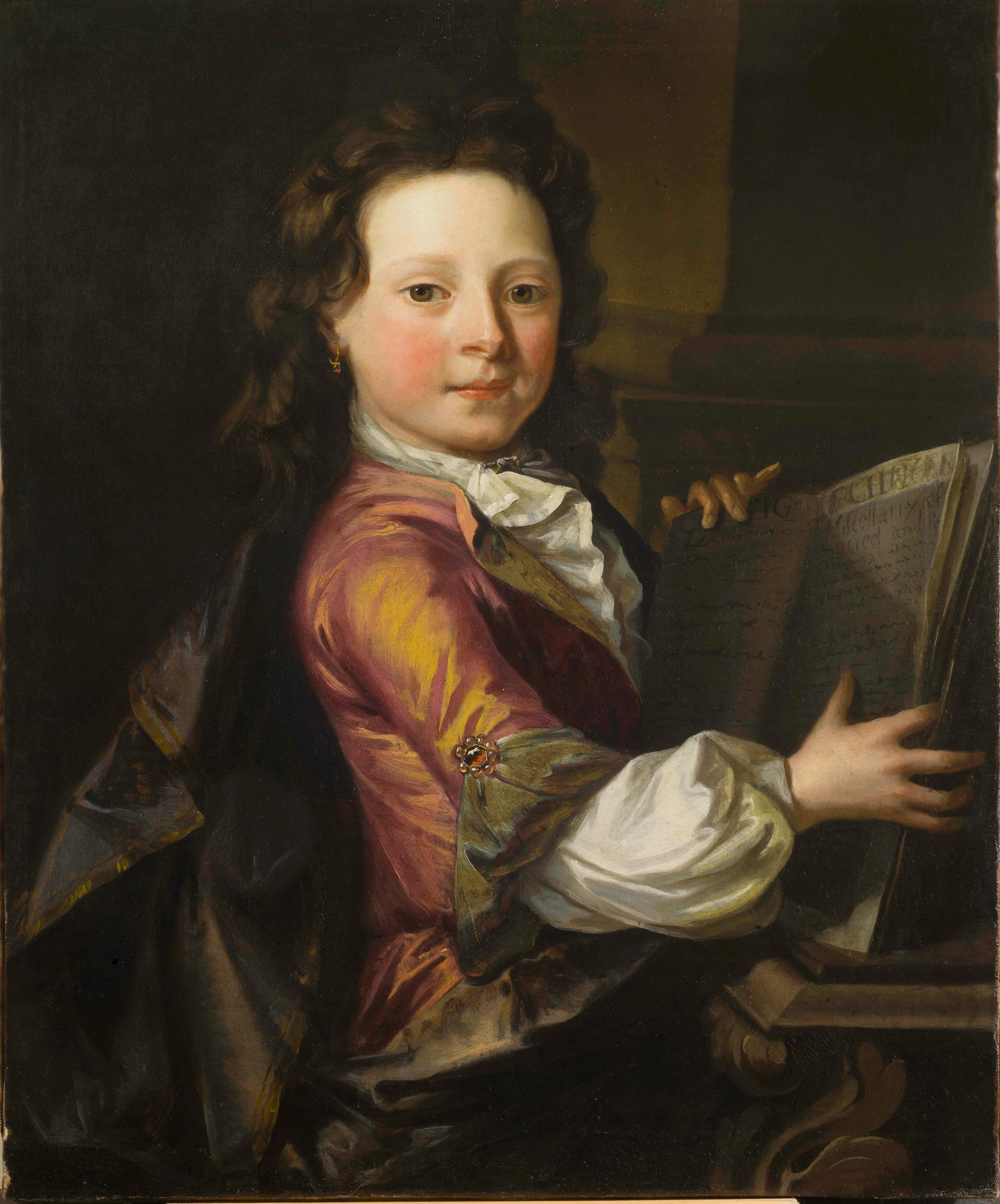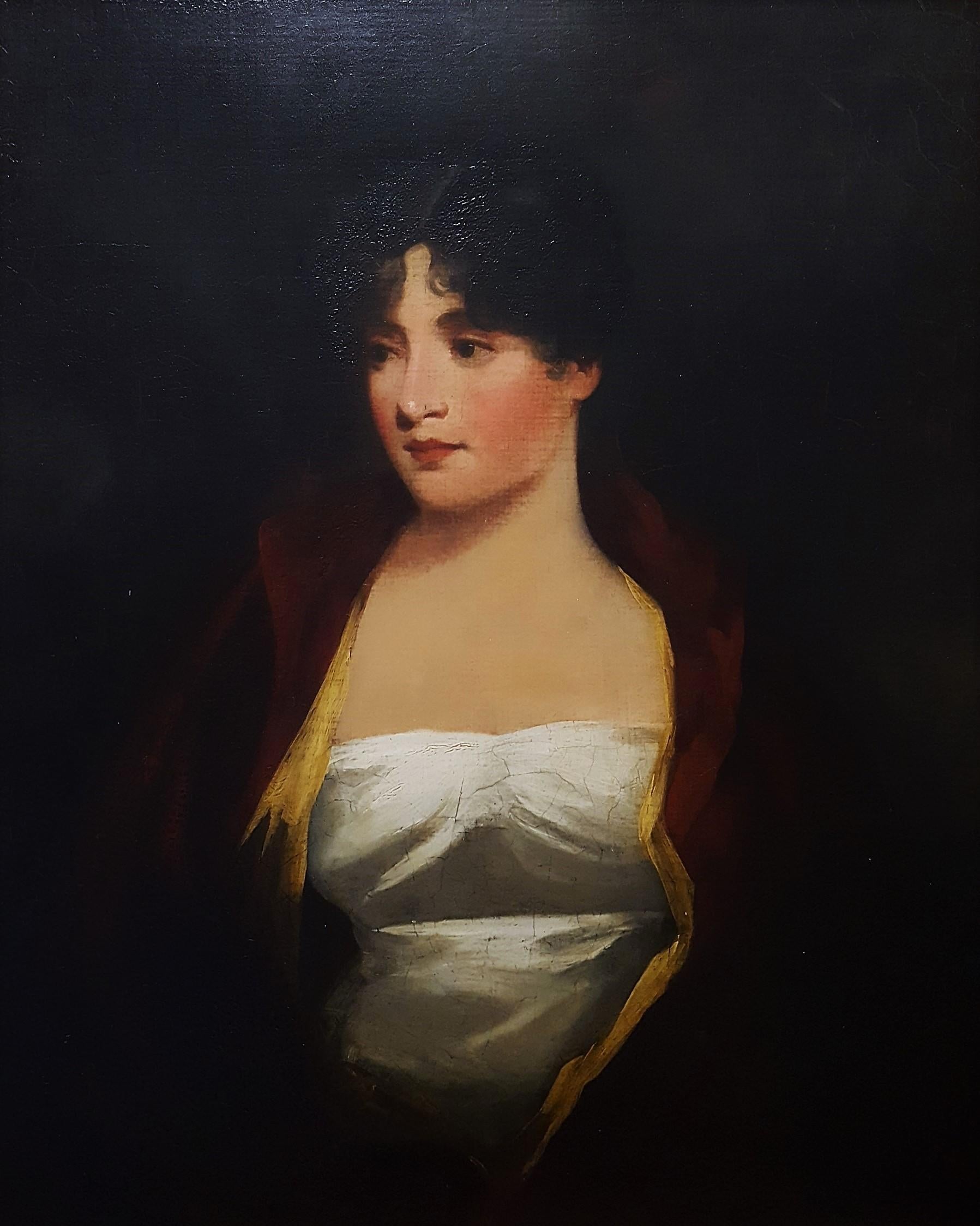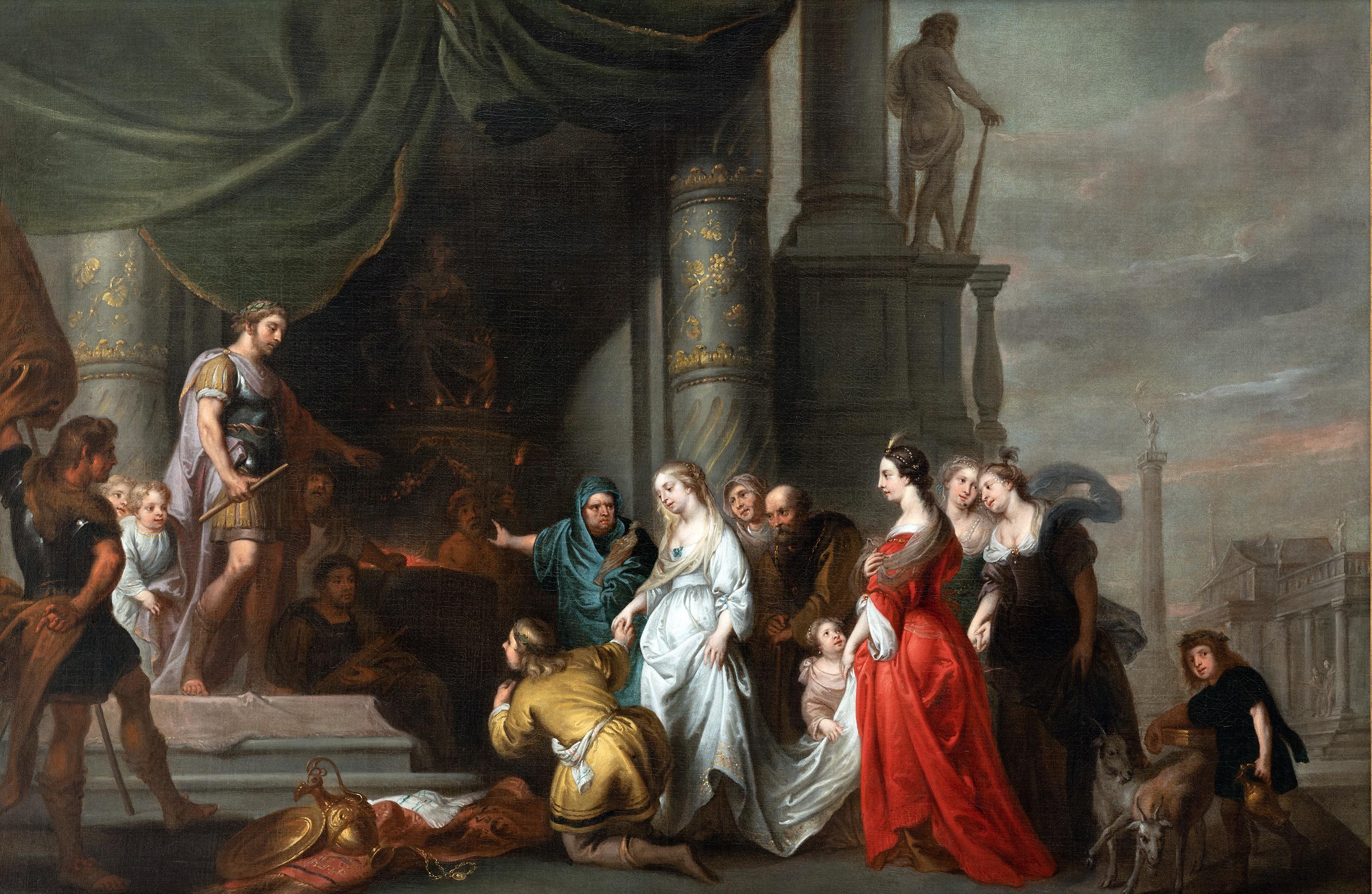Items Similar to English 17th century portrait of a lady in an ivory silk gown on a terrace
Want more images or videos?
Request additional images or videos from the seller
1 of 12
John GreenhillEnglish 17th century portrait of a lady in an ivory silk gown on a terracec.1670
c.1670
About the Item
Portrait of a 17th century lady, three-quarter length, in an ivory silk gown standing on a garden terrace.
The lady, painted circa 1670, gestures with her hand towards the gardens and land beyond off her country estate, wearing a sumptuous ivory silk gown adorned with pearls and precious stones and pearl earrings and necklace, signaling her wealth and status. She wears a ring on her left hand, which combined with her pale gown possibly alludes to her recent marriage. There are traces of a signature in ligature 'JG' in a lower fold of the sitter's right hand sleeve.
John Greenhill was a highly skilled and talented painter whose life and career were cut tragically short. He was born in Salisbury circa 1644 and was the son of John Greenhill, a merchant and later the local registrar and Penelope Champneys of Orchardleigh, Somerset. Greenhill's early artistic training is unknown but it is believed his first portrait was of his uncle, James Abbot of Salisbury. He moved to London in 1662 and became a pupil of Sir Peter Lely, court painter to Charles II. At the start of his career, Greenhill was hard working and ambitious and according to George Vertue was considered to be 'the most excellent of Lely's disciples'. His style was clearly influenced by Lely and Van Dyck and he progressed rapidly to leave and form his own studio.
Although he painted a variety of sitters such as James Duke of York (Dulwich Picture Gallery) and John Locke and Anthony Ashley, earl of Shaftesbury, he greatly enjoyed being at the heart of the Covent Garden theatre scene and the company and social life surrounding it and painted a great many playwrights, actors and their circle. He painted in oils but also produced a great many sketches and drawings in chalk which had become very popular at the time.
According to the diarist George Vertue, this led Greenhill to lead what he described as a 'dissolute' lifestyle and on May 1676, while returning home one evening drunk from the Vine Tavern, he fell into the gutter in Long Acre, was carried home to his lodgings in Lincoln's Inn Fields and died the same night, aged only 31. He was buried in nearby St Giles-in-the Fields. He had married young and Peter Lely gave his widow and young family an annuity to live on.
Greenhill is recognized for his skill and talent in portrait painting and his early death make the few existing portraits that he produced extremely rare. He was described in an epitaph written by his friend, the writer and actress Aphra Behn as 'The famous Greenhill'. Another writer, Bainbrigg Buckeridge, wrote in his 'Essay towards an English school' of 1706 that had he not died young, the effect of his too free living, England might have boasted a Painter who according to his beginnings, could not have been much inferior to the very best of Foreigners... whom we have always so much encourag'd in the portrait way.
Provenance: Scottish Borders private collection
Literature:
Ellis Waterhouse, 'Dictionary of 16th and 17th century British Painters', 1981
Dethloff D, 'Greenhill, John (1644?–1676), portrait painter'. Oxford Dictionary of National Biography. online version, May 2021
- Creator:John Greenhill (1646 - 1676, English)
- Creation Year:c.1670
- Dimensions:Height: 47.64 in (121 cm)Width: 40.16 in (102 cm)
- Medium:
- Movement & Style:
- Period:
- Condition:
- Gallery Location:Bath, GB
- Reference Number:1stDibs: LU95212161172
About the Seller
5.0
Vetted Seller
These experienced sellers undergo a comprehensive evaluation by our team of in-house experts.
Established in 2002
1stDibs seller since 2015
37 sales on 1stDibs
Typical response time: 1 hour
Associations
The British Antique Dealers' AssociationLAPADA - The Association of Arts & Antiques DealersInternational Confederation of Art and Antique Dealers' Associations
- ShippingRetrieving quote...Ships From: Bath, United Kingdom
- Return PolicyA return for this item may be initiated within 3 days of delivery.
More From This SellerView All
- English 17th century portrait of a ladyBy Sir Peter LelyLocated in Bath, SomersetA 17th century English portrait of a lady by Sir Peter Lely (1618-1680), half-length in a painted feigned oval, wearing a green silk gown with chestnut coloured cloak over one shoulder, her fair hair curled in the fashionable ringlet style of the period. Oil on canvas in an English giltwood 'Lely' frame. We are grateful to Diana Dethloff and Catharine MacLeod (who are currently working on a Lely catalogue raisonné) for their confirmation of Lely as the artist from photograph analysis of this previously unidentified early work. Provenance: Private collection Nottingham until 2021 Mellors and Kirk sale December 2000, lot 1173 The sitter is likely to have been from an upper class or aristocratic family in court circles, who were the main source of Lely`s patronage. The simple composition serves to highlight the beauty of the sitter through portraying her pale decolletage and complexion, set against the gentle gaze of her blue eyes, the soft blush of her cheeks and her full red lips. Peter Lely (1618-1680) was originally of dutch origin and became Principle Painter to the King in 1661, following in the footsteps of Van Dyck who had died in 1641. He dominated the portrait painting scene in England for over 20 years, creating a distinctive 'court look' in his work which had a strong influence on many other artists. He had an extremely successful and popular portrait practice which meant that he soon had to develop production methods that could accommodate the high demand for portraits, and also for copies and versions of them which were given as gifts to family and courtiers. The use of studio assistants was a common practice for busy artists and as with Van Dyck, Lely is known to have used specialist assistants to execute particular parts of his paintings. Artists who worked in Lely`s studio included John Baptist Gaspars who specialised in drapery painting, William Wissing, John Greenhill...Category
17th Century Baroque Portrait Paintings
MaterialsOil, Canvas
- English 17th century portrait of John Ludford EsquireBy Mary BealeLocated in Bath, SomersetPortrait of John Ludford (1653-1681), wearing a lace jabot and brown and gold trimmed cloak in a feigned stone oval cartouche. Inscribed 'John Ludford, Esq, nat. 14th March 1653, Ob,...Category
Late 17th Century Baroque Portrait Paintings
MaterialsCanvas, Oil
- A portrait of a lady and her daughter with an exotic birdBy Michael DahlLocated in Bath, SomersetA portrait of a lady three-quarter length, seated in an interior, wearing a red silk gown draped in a pink silk sash with an exotic bird perched on her hand and one arm resting on a stone plinth, her young daughter wearing a green silk gown standing at her side. Oil on canvas, housed in a period 'Lely' giltwood frame. This double portrait was painted at the height of Dahl's career in circa 1715 when Dahl had become firmly established as one of the leading portrait painters in Britain. Although the identities of the sitters are currently unknown, it is a sensitive depiction of a close and affectionate bond between a mother and daughter, with the young girl's hand resting affectionately on her mothers lap. The tamed exotic bird adds a charming decorative element which also serves to convey the high social status of the lady, given only the very wealthy would be able to own such a rare and expensive pet and the lively colouring of the bird's feathers is reflected in the colours of the sitters' silk gowns. Provenance: Private collection, London Michael Dahl (Stockholm 1659-1743 London) was born in Stockholm in Sweden and studied under Martin Hannibal (d 1741) and later with David Klöcker Ehrenstrahl. In 1682 he travelled to London, where he became acquainted with Godfrey Kneller and Henry Tilson, and in 1685 he left for Europe with Tilson, working briefly in Paris before continuing to Venice and Rome, where they stayed for about two years. In Rome Dahl converted to Roman Catholicism and gravitated towards the circle of Christina, former Queen of Sweden, who sat for him (Grimsthorpe Castle, Lincs). He returned to England with Tilson via Frankfurt and arrived in London in 1689, staying in England for the remainder of his career. During Dahl's absence, Kneller had consolidated his supremacy in London as the most fashionable portrait painter, but Dahl rapidly became Kneller’s closest competitor. His patrons probably had roots in the Swedish diplomatic circles, but it expanded as a result of his ability and his agreeable personality. His prices were lower than those of Kneller and he favoured softer, more diffused, colour tones and could respond to his sitters with sincerity and humanity. Politically, Kneller supported the ascendant Whigs while Dahl was a Tory, but they frequently painted the same sitters from both parties, and in spite of fundamental differences in technique and temperament, their work was sometimes similar in appearance. Dahl was prolific but rarely signed his work, and comparatively few of his portraits were engraved in mezzotint, the method used by Kneller to widen his reputation. By 1690 he had painted the aged Duke of Schomberg (engraved by William Faithorne) and Prince George of Denmark (London, Kensington Palace). He was ignored by William III but received commissions from Princess Anne, including one for a portrait of herself (Oakly Park, Ludlow, Salop). He also painted the future Duke and Duchess of Marlborough, and his informal portrait of the Duchess (Althorp House, Northants), formerly attributed to Kneller, is perhaps the most intimate of all images of her. During the 1690s he secured the patronage of Charles Seymour, the ‘Proud’ 6th Duke of Somerset, who ordered a series of seven full-length portraits of notable contemporary beauties from Dahl (1690s; Petworth House, W. Sussex, NT). This was originally a scheme similar to Kneller’s more famous ‘Hampton Court Beauties’, but the portraits were subsequently reduced to three-quarter-length formats. The features of the sitters are not individualized, but they possess a decorative, languorous glamour that recalls Lely rather than Kneller. Somerset gave Dahl further employment over the next 25 years. In 1698, following the death of Klöcker Ehrenstrahl, Dahl was offered the post of court painter at Stockholm, which he apparently refused, preferring to remain in London at his studio in Leicester Fields, near the Swedish legation. In about 1700 he was joined by a young compatriot, Hans Hysing, who worked with him for many years. Dahl seems not to have married until after 1708, He had a son Michael (d. 1741), also a painter, of whose work nothing is known, and two daughters. After the accession of Queen Anne in 1701, she and Prince George sat for a number of official portraits. His royal patronage ceased with Queen Anne’s death, and when Dahl refused to paint the infant Duke of Cumberland in 1722. He was suspected of Jacobite sympathies, and relations had cooled between him and the Swedish legation. However, his practice continued to prosper, and he acquired another important patron in Edward Harley, 2nd Earl of Oxford, who shared his political views and whose circle included the architect James Gibbs and the poets Matthew Prior and Alexander Pope, all of whom Dahl painted. Oxford commissioned several portraits of himself. In the earliest (1719; Welbeck Abbey...Category
Early 18th Century Old Masters Portrait Paintings
MaterialsCanvas, Oil
- 18th century portrait of the German Flautist and composer Johann Joachim QuantzBy Arthur DevisLocated in Bath, SomersetPortrait of Johann Quantz (1697-1773), flautist and composer, wearing a blue velvet coat, waistcoat and breeches, standing in a garden landscape with ...Category
18th Century English School Portrait Paintings
MaterialsOil, Canvas
- 17th century Dutch portrait of a Lady in Red adorned with PearlsBy Pieter NasonLocated in Bath, SomersetPortrait of a lady, half-length in a feigned oval wearing a ruby coloured silk gown holding entwined strings of pearls across her bodice. Signed 'PNason' and dated 1667 (lower right)...Category
17th Century Old Masters Portrait Paintings
MaterialsOil, Canvas
- 17th century portrait of a ladyBy Nicolaes MaesLocated in Bath, SomersetPortrait of a lady richly dressed in a purple silk gown with white sleeves, a gold coloured cloak draped across one shoulder, her blonde curls worn up...Category
17th Century Old Masters Portrait Paintings
MaterialsCanvas, Oil
You May Also Like
- Portrait of a Boy, John Closterman, Large English Portrait Art, Old MasterBy John ClostermanLocated in Greven, DEJohn Clostermann (Osnabrück 1660 - 1711 London) Portrait of a boy, maybe Charles Hinde Oil on canvas, 61 x 74,6 cm John Closterman (also Klosterman) was a portrait painter of the late 17th and early 18th centuries. He primarily portrayed English noblemen and European aristocratic families. His father was already an artist and he trained his son. In 1679 he went to Paris and studied with Francois de Troy. In 1681 he was in London and worked for the artist John Riley, whose studio he took over after his death. In 1696 he was invited to the Spanish court...Category
17th Century Baroque Figurative Paintings
MaterialsCanvas, Oil
- G Negri called Il Boccia Baroque Figurative Painting 17th century oil canvasBy Girolamo Negri called Il BocciaLocated in Florence, ITOil on canvas, 62 x 51 cm (without the frame) Even if on the background there is an attribution to “Francesco Gessi pupil of Guido Reni” by the bolognese art historian Guido Zucchini (dated 1945), recent studies are tending to add it to the corpus of Girolamo Negri called Il Boccia (Bologna 1648-1718) due to lots of similarities with his style (the pale and warm palette chosen, the profile) The painting represents a lady on profile wearing a brown turban, a yellow clock...Category
Late 17th Century Baroque Figurative Paintings
MaterialsCanvas, Oil
- Old man elderly oil on board paintingLocated in Barcelona, BarcelonaAnonymous - Old man - Oil on board Oil size 34x25 cm. FramelessCategory
1920s Baroque Portrait Paintings
MaterialsCanvas, Oil
- Ritratto figurativo maschile scuola toscana del XVII secolo olio su telaLocated in Florence, ITDipinto di scuola toscana della seconda metà del XVII secolo raffigurante un ritratto maschile di tre quarti, immerso nell'eleganza e nella maestosità proprie dell'epoca. La figura è...Category
Late 17th Century Baroque Portrait Paintings
MaterialsCanvas, Oil
- Portrait of Margaritta MacDonald in red jacket and white gown (half-length)By Sir Henry RaeburnLocated in Saint Augustine, FLArtist: (after) Sir Henry Raeburn (Scottish, 1756-1823) Title: "Portrait of Margaritta MacDonald in red jacket and white gown (half-length)" *No signature found Circa: 1820 Medium: O...Category
1820s Baroque Portrait Paintings
MaterialsCanvas, Paint, Oil, Gesso
- Continence of Scipio, Erasmus Quellinus, School Rubens, Baroque Art, Old MasterBy Erasmus Quellinus the YoungerLocated in Greven, DEErasmus Quellinus The Continence of Scipio Oil on Canvas The painting is included in the Catalogue Raisonné of the artist. The Roman commande...Category
17th Century Baroque Figurative Paintings
MaterialsOil, Canvas
Recently Viewed
View AllMore Ways To Browse
What Is A Antique
Portrait Of Actor
Portrait Of An Actor
Ivory Art D
Antique Painting On Silk
Duke Of York
Antique English 17th Century
Antique Long Johns
Portraits On Ivory
British 17th Century
Ivory Dior
Oil Portrait Scotland
Scottish Portrait Oil Painting
Anthony John
Antique Ivory Paint
16th Century English
English Sirs Portraits
Too Young To Die




